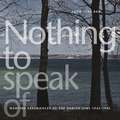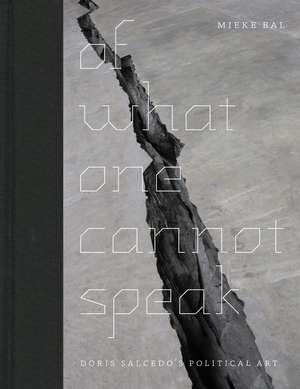Of What One Cannot Speak: Doris Salcedo's Political Art: Emersion: Emergent Village resources for communities of faith
Autor Mieke Balen Limba Engleză Hardback – 30 ian 2011
In Of What One Cannot Speak, Bal leads us into intimate encounters with Salcedo’s art, encouraging us to consider each work as a “theoretical object” that invites—and demands—certain kinds of considerations about history, death, erasure, and grief. Bal ranges widely through Salcedo’s work, from Salcedo’s Atrabiliarios series—in which the artist uses worn shoes to retrace los desaparecidos (“the disappeared”) from nations like Argentina, Chile, and Colombia—to Shibboleth, Salcedo’s once-in-a-lifetime commission by the Tate Modern, for which she created a rupture, as if by earthquake, that stretched the length of the museum hall’s concrete floor. In each instance, Salcedo’s installations speak for themselves, utilizing household items, human bones, and common domestic architecture to explore the silent spaces between violence, trauma, and identity. Yet Bal draws out even deeper responses to the work, questioning the nature of political art altogether and introducing concepts of metaphor, time, and space in order to contend with Salcedo’s powerful sculptures and installations.
An unforgettable fusion of art and essay, Of What One Cannot Speak takes us to the very core of events we are capable of remembering—yet still uncomfortably cannot speak aloud.
Din seria Emersion: Emergent Village resources for communities of faith
-
 Preț: 144.99 lei
Preț: 144.99 lei -
 Preț: 133.99 lei
Preț: 133.99 lei - 9%
 Preț: 352.50 lei
Preț: 352.50 lei -
 Preț: 146.50 lei
Preț: 146.50 lei -
 Preț: 208.31 lei
Preț: 208.31 lei -
 Preț: 156.84 lei
Preț: 156.84 lei -
 Preț: 115.53 lei
Preț: 115.53 lei -
 Preț: 548.71 lei
Preț: 548.71 lei - 8%
 Preț: 346.31 lei
Preț: 346.31 lei - 8%
 Preț: 360.28 lei
Preț: 360.28 lei -
 Preț: 216.89 lei
Preț: 216.89 lei -
 Preț: 101.43 lei
Preț: 101.43 lei -
 Preț: 215.51 lei
Preț: 215.51 lei -
 Preț: 185.37 lei
Preț: 185.37 lei - 8%
 Preț: 563.24 lei
Preț: 563.24 lei -
 Preț: 179.04 lei
Preț: 179.04 lei -
 Preț: 106.35 lei
Preț: 106.35 lei -
 Preț: 138.81 lei
Preț: 138.81 lei -
 Preț: 273.93 lei
Preț: 273.93 lei -
 Preț: 128.11 lei
Preț: 128.11 lei - 9%
 Preț: 353.24 lei
Preț: 353.24 lei -
 Preț: 176.49 lei
Preț: 176.49 lei -
 Preț: 94.22 lei
Preț: 94.22 lei -
 Preț: 144.80 lei
Preț: 144.80 lei -
 Preț: 126.25 lei
Preț: 126.25 lei -
 Preț: 67.35 lei
Preț: 67.35 lei -
 Preț: 163.52 lei
Preț: 163.52 lei -
 Preț: 138.26 lei
Preț: 138.26 lei -
 Preț: 182.98 lei
Preț: 182.98 lei - 18%
 Preț: 502.35 lei
Preț: 502.35 lei - 18%
 Preț: 2261.34 lei
Preț: 2261.34 lei -
 Preț: 279.55 lei
Preț: 279.55 lei -
 Preț: 115.82 lei
Preț: 115.82 lei -
 Preț: 208.54 lei
Preț: 208.54 lei -
 Preț: 167.85 lei
Preț: 167.85 lei -
 Preț: 160.63 lei
Preț: 160.63 lei -
 Preț: 183.89 lei
Preț: 183.89 lei - 9%
 Preț: 352.77 lei
Preț: 352.77 lei -
 Preț: 307.53 lei
Preț: 307.53 lei - 12%
 Preț: 290.56 lei
Preț: 290.56 lei - 8%
 Preț: 311.68 lei
Preț: 311.68 lei -
 Preț: 120.81 lei
Preț: 120.81 lei -
 Preț: 229.92 lei
Preț: 229.92 lei - 6%
 Preț: 324.95 lei
Preț: 324.95 lei -
 Preț: 145.41 lei
Preț: 145.41 lei -
 Preț: 125.41 lei
Preț: 125.41 lei -
 Preț: 147.26 lei
Preț: 147.26 lei - 18%
 Preț: 348.59 lei
Preț: 348.59 lei -
 Preț: 302.76 lei
Preț: 302.76 lei - 8%
 Preț: 564.99 lei
Preț: 564.99 lei
Preț: 417.96 lei
Preț vechi: 506.49 lei
-17% Nou
Puncte Express: 627
Preț estimativ în valută:
79.97€ • 83.73$ • 66.18£
79.97€ • 83.73$ • 66.18£
Carte indisponibilă temporar
Doresc să fiu notificat când acest titlu va fi disponibil:
Se trimite...
Preluare comenzi: 021 569.72.76
Specificații
ISBN-13: 9780226035789
ISBN-10: 0226035786
Pagini: 296
Ilustrații: 28 color plates, 31 halftones
Dimensiuni: 178 x 254 x 25 mm
Greutate: 1.08 kg
Editura: University of Chicago Press
Colecția University of Chicago Press
Seria Emersion: Emergent Village resources for communities of faith
ISBN-10: 0226035786
Pagini: 296
Ilustrații: 28 color plates, 31 halftones
Dimensiuni: 178 x 254 x 25 mm
Greutate: 1.08 kg
Editura: University of Chicago Press
Colecția University of Chicago Press
Seria Emersion: Emergent Village resources for communities of faith
Notă biografică
Mieke Bal is Academy Professor at the Royal Netherlands Academy of Arts and Sciences and a cofounder of the Amsterdam School for Cultural Analysis at the University of Amsterdam. Her many books include Loving Yusuf: Conceptual Travels from Present to Past, also published by the University of Chicago Press.
Cuprins
List of Illustrations
Acknowledgments
Introduction
Acknowledgments
Introduction
The Case
The World
The Book
The World
The Book
1 Metaphoring: Singularity in Negative Space
Metaphor and Negative Space
Metaphoring Negativity
The Insistence of Metaphor
The Act of Metaphoring
Metaphor as Skin
Atrabiliarios as Political Object
2 The Politics of Anthropomorphism
The Anthropomorphic Imagination
Locating Violence
House Without Spouse
Theaters of Gender
On the Move
3 Timing
Negations of Place
No More Bones
Foreshortening
Foreshortening Time
4 The Agency of Space: Installation
Listening to Time in Space
Abduction into Pain
History and the Event in the Present
New Space
5 Acts of Memory
An Act in Search of an Agent
Perception and Memory for Witnessing
Acting Memory
Meanwhile: Herenow
Active Space
Shibboleth of Past and Present
Conclusion: Political Art Takes Place
Epilogue
References
Index
Recenzii
“After illuminating the work of Rembrandt, Caravaggio, Louise Bourgeois, Balthus, and other modern artists, Mieke Bal again demonstrates her extraordinary flair for cultural criticism in taking on the work of Doris Salcedo, exploring the philosophical and aesthetic stakes of this committed political art and the relation between beauty, violence, and memory. A tour de force.”
“Seen against Bal’s magnificent oeuvre, Of What One Cannot Speak is the next innovative and brilliant book that will once again push the field of visual studies into unexplored areas. A fusion of monograph and theoretical essay, the book is best described as a demonstration of Bal teaching. She crucially teaches her audience how to make an encounter with an artwork productive—not by applying theoretical ideas, but by working through the object’s resistance, by allowing the object to speak back to you. Bal does not simply take Doris Salcedo’s work as her starting point, and neither does she argue that the violence of the political is somehow merely ‘reflected’ in it. Instead, she embarks on a much more ambitious and original project—initiating a discourse by allowing a work of art to take the lead.”
“Of What One Cannot Speak offers a brilliant theoretical challenge to our understanding of the political in art after Adorno and after trauma theory. Mieke Bal gives us the most insightful and comprehensive reading to date of the work of Doris Salcedo as a new kind of ‘world art’ that cannot be relegated reductively to local color or to thematic dimensions such as memory and violence. Equally attentive to Salcedo’s materials as to her handling of metaphor and figuration, space and time, Bal’s book stands as a model work on the threshold between art criticism and interpretive analysis—truly interdisciplinary in the best sense.”
“Bal is a leading cultural critic, known for her engaging writing style and clarity, even when dealing with difficult theoretical concepts. Bal also has incredible respect for Salcedo and her work, as this book models a process of investigation akin to a dialogue with art, rather than a clinical dissection of it. Essential.”
